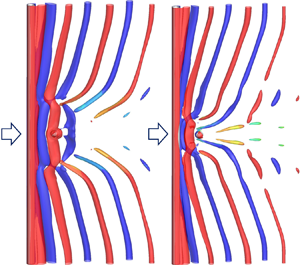Article contents
Flow past a circular cylinder and a downstream sphere for Re < 300
Published online by Cambridge University Press: 01 March 2021
Abstract

Flow past a circular cylinder and a downstream sphere is simulated numerically for Reynolds numbers between 100 and 300 for cylinder-to-sphere gap ratios between 0 and 3. The aim of this study is to investigate the influence of the sphere on the vortex shedding of the cylinder, and the wake-induced forces on the sphere. If vortices are shed from the cylinder upstream of the sphere, vortices are disconnected after they pass the sphere. This type of vortex disconnection is defined as sphere-induced vortex disconnection. The key finding is the so-called sphere-induced vortex dislocation (SIVDL) which occurs within the vortex formation region. The main characteristics of SIVDL include the adhesion of vortices to the cylinder at dislocation positions, and periodical occurrences of SIVDL. The periodic occurrence of SIVDL makes the frequency of vortex shedding change over time. Another interesting phenomenon is the reattachment of the separated shear layers from the cylinder to the sphere, which occurs when the sphere–cylinder gap is small. This leads to the formation of vortices without disconnection downstream of the sphere that it is similar to the case of tandem cylinders. In all cases, vortices are inclined, and their angle of inclination increases when SIVDL occurs. SIVDL reduces the frequency of the lift coefficient and increases the standard deviation of the drag coefficient of the sphere. The periodic occurrence of SIVDL causes the beating of the lift coefficient along with large-amplitude, low-frequency oscillations of the sphere's drag coefficient.
JFM classification
Information
- Type
- JFM Papers
- Information
- Copyright
- © The Author(s), 2021. Published by Cambridge University Press
References
- 15
- Cited by


